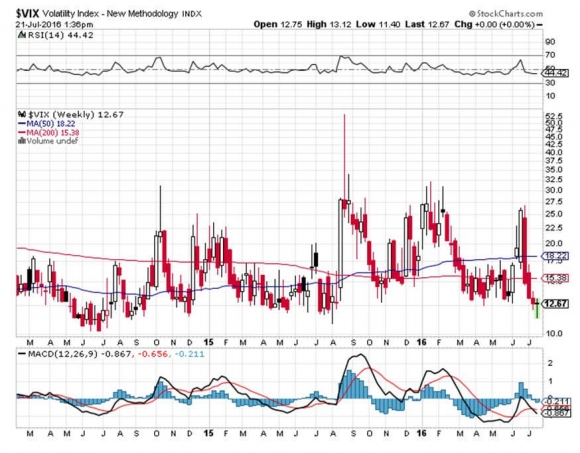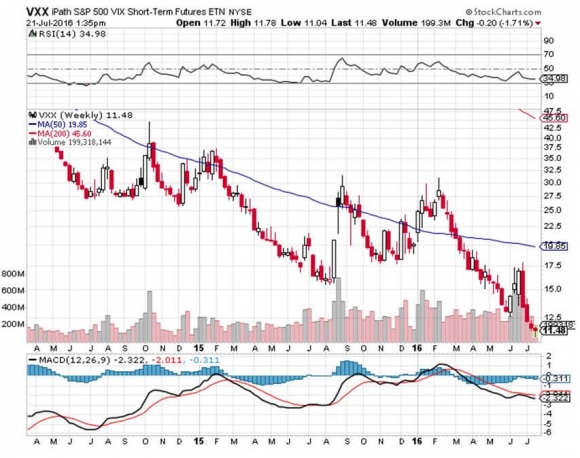The Volatility Bottom Is In
On Wednesday I voiced my opinion that, after hitting a decade low at $11.35, the Volatility Index (VIX) would go no lower.
Since that spike down, the (VIX) has rocketed by 15%.
If this continues to be right, you want to use every subsequent (VIX) dip to go long.
I am one of those cheapskates who buys Christmas ornaments by the bucket load from Costco in January for ten cents on the dollar, because my eleven month theoretical return on capital comes close to 1,000%.
I also like buying flood insurance in the middle of the summer drought, when the forecast in California is for endless days of sunshine.
That is what we are facing now with the volatility index (VIX) where premiums probed such rock bottom prices.
Get this one right, and the profits you can realize are spectacular.
If the bottom in volatility exactly coincides with the peak in the stock market that it measures, volatility could be headed back up to the 20 handle, and maybe more.
I double dare you to look at the charts below and tell me this isn’t happening.
Watch carefully for other confirming trends to affirm this trade is unfolding. Those would include a strong dollar, falling stocks, plunging oil, and a weak Yen, Euro, and fixed income instruments of any kind.
Notice that every one of these is happening this week.
The CBOE Volatility Index (VIX) is a measure of the implied volatility of the S&P 500 stock index, which has been rallying hard since the post Brexit pop started four weeks ago.
It has been one of the most frantic rallies in stock market history, taking the Dow Average up an incredible 9 days in a row.
Reversion to the mean, anyone?
You may know of this from the many clueless talking heads, beginners, and newbies who call (VIX) the “Fear Index”.
For those of you who have a PhD in higher mathematics from MIT, the (VIX) is simply a weighted blend of prices for a range of options on the S&P 500 index.
The formula uses a kernel-smoothed estimator that takes as inputs the current market prices for all out-of-the-money calls and puts for the front month and second month expirations.
The (VIX) is the square root of the par variance swap rate for a 30 day term initiated today. To get into the pricing of the individual options, please go look up your handy dandy and ever useful Black-Scholes equation.
You will recall that this is the equation that derives from the Brownian motion of heat transference in metals. Got all that?
For the rest of you who do not possess a PhD in higher mathematics from MIT, and maybe scored a 450 on your math SAT test, or who don’t know what an SAT test is, this is what you need to know.
When the market goes up, the (VIX) goes down. When the market goes down, the (VIX) goes up. Period. End of story. Class dismissed.
The (VIX) is expressed in terms of the annualized movement in the S&P 500, which today is at $2,163.
So for example, a (VIX) of $14 means that the market expects the index to move 4.0%, or 72 S&P 500 points, over the next 30 days.
You get this by calculating $14/3.46 = 4.0%, where the square root of 12 months is 3.46.
The volatility index doesn’t really care which way the stock index moves. If the S&P 500 moves more than the projected 4.0%, you make a profit on your long (VIX) positions.
Probability statistics suggest that there is a 68% chance (one standard deviation) that the next monthly market move will stay within the 4.0% range.
I am going into this detail because I always get a million questions whenever I raise this subject with volatility-deprived investors.
It gets better. Futures contracts began trading on the (VIX) in 2004, and options on the futures since 2006.
Since then, these instruments have provided a vital means through which hedge funds control risk in their portfolios, thus providing the “hedge” in hedge fund.
If you make money on your (VIX) trade, it will offset losses on other long positions. This is how the big funds most commonly use it.
No one who buys fire insurance ever complains when their house doesn’t burn down.






Make Volatility Your Friend, Not Your Enemy
The Diary of a Mad Hedge Fund Trader, published since 2008, ...
more


